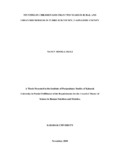STUNTING IN CHILDREN LESS THAN TWO YEARS IN RURAL AND URBAN HOUSEHOLDS IN TURBO SUB COUNTY, UASIN GISHU COUNTY
Abstract
Globally about one fifth of children less than five years are stunted with more than a third from Africa. Stunting is low length for age with poor cognitive and physical development. It occurs in the first 1000 days of life increasing morbidity, mortality, reduced individual output and chronic conditions. Since surveys indicate stunted children are also found in food secure households with good access to diverse foods, there seems to be a major research gap on factors contributing to stunting in this households, more so in Turbo Sub County. The purpose of this study was to determine the contributors to high prevalence of stunting(31.2%) in Turbo, Uasin Gishu County. The study findings will inform the county on effective intervention strategies. The study objective was to find out contributors of stunting in food secure households in children less than two years in Turbo, UGC. Cross-sectional survey design was used for this study. A sample size of 331 stunted children aged 0-23 months were recruited using multistage, systematic random sampling. The results indicate that their biological mothers cared for 92.1% of the children. Children below six months were exclusively breastfed at 40.3% with more urban children than rural at χ2(P=0.001). Continued breastfeeding at one year was 67.3% and at two years 47.1%. More rural children had a dietary diversity score of ≥4 than urban with χ2(P=0.004). Dairy (66.4%) and business (46.9%) were the most practiced economic activities. There was poor knowledge on meal frequency with no difference between rural and urban at χ2(P=0.033) and χ2(P=0.019) for 9-11 and 12-23 months respectively. Rural families that produced milk fed it to children Fishers exact test χ2(P=0.004). The study indicate poor feeding practices for stunted children and recommends training caregivers on infant and young child nutrition.

